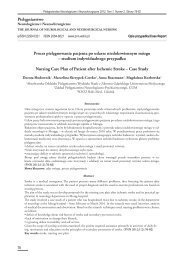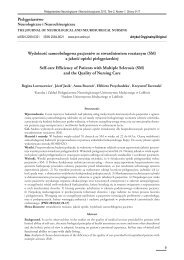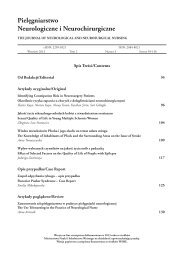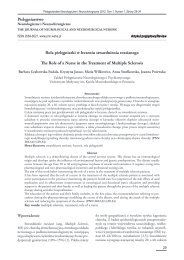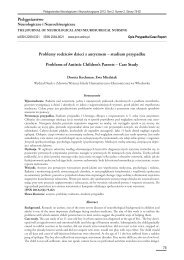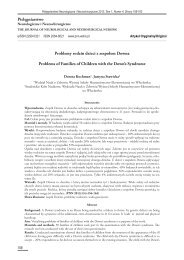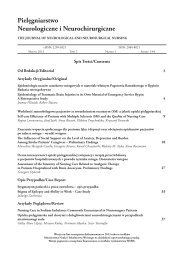PielÄgniarstwo Functional Capacity Scale (FCS) in Nursing ... - PNN
PielÄgniarstwo Functional Capacity Scale (FCS) in Nursing ... - PNN
PielÄgniarstwo Functional Capacity Scale (FCS) in Nursing ... - PNN
You also want an ePaper? Increase the reach of your titles
YUMPU automatically turns print PDFs into web optimized ePapers that Google loves.
Pielęgniarstwo Neurologiczne i Neurochirurgiczne 2012, Tom 1, Numer 1, Strony 35-40<br />
Pielęgniarstwo<br />
Neurologiczne i Neurochirurgiczne<br />
THE JOURNAL OF NEUROLOGICAL AND NEUROSURGICAL NURSING<br />
ISSN 2084-8021, www.pnn.wshe.pl<br />
Artykuł poglądowy/Review<br />
<strong>Functional</strong> <strong>Capacity</strong> <strong>Scale</strong> (<strong>FCS</strong>) <strong>in</strong> Nurs<strong>in</strong>g Practice<br />
Skala Wydolności Funkcjonalnej (<strong>FCS</strong>) w praktyce pielęgniarskiej<br />
Robert Ślusarz<br />
Neurological and Neurosurgical Nurs<strong>in</strong>g Department, Collegium Medicum <strong>in</strong> Bydgoszcz, Nicolaus Copernicus<br />
University <strong>in</strong> Torun, Poland<br />
Abstract<br />
In the medical practice of a neurological and neurosurgical nurse, the scor<strong>in</strong>g scales are used for measur<strong>in</strong>g the<br />
degree of damage (neurological deficit), for the functional assessment of a patient (motor abilities) and for the assessment<br />
of the patient’s comfort (the effects the illness may have on psyche and the patient’s social life).<br />
Recent studies (<strong>in</strong> the field of neurological and neurosurgical nurs<strong>in</strong>g), assess<strong>in</strong>g patient’s condition dur<strong>in</strong>g hospitalization,<br />
tend to focus on determ<strong>in</strong><strong>in</strong>g patient’s functional capacity <strong>in</strong> the scope of self care. Self care is related to<br />
functional capacity which is patient’s ability to act <strong>in</strong>dependently <strong>in</strong> satisfy<strong>in</strong>g basic life needs.<br />
Based on rich experience of the Neurosurgery and Neurotraumatology Cl<strong>in</strong>ic <strong>in</strong> Bydgoszcz <strong>in</strong> the field of assessment<br />
of functional capacity <strong>in</strong> patients with nervous system disorders (subarachnoid hemorrhage, <strong>in</strong>tracranial<br />
aneurysm, bra<strong>in</strong> tumour and low back pa<strong>in</strong>), a new scale (<strong>FCS</strong>) for assessment of these patients was developed.<br />
(<strong>PNN</strong> 2012;1(1):35-40)<br />
Key words: functional capacity scale, neurosurgery, nurs<strong>in</strong>g<br />
Streszczenie<br />
W praktyce pielęgniarki neurologicznej, neurochirurgicznej skale punktowe (scor<strong>in</strong>g scales), wykorzystuje się<br />
do pomiaru stopnia uszkodzenia (określenia deficytu neurologicznego), do oceny funkcjonalnej chorego (przede<br />
wszystkim określenia sprawności motorycznej) oraz do oceny jakość życia (aspekty psychosocjalne choroby).<br />
Aktualne badania (z dziedz<strong>in</strong>y pielęgniarstwa neurologicznego i neurochirurgicznego), oceniające stan chorego<br />
w okresie hospitalizacji skłaniają się do określenia stopnia wydolności chorego w zakresie samoopieki. Term<strong>in</strong><br />
ten związany jest z wydolnością funkcjonalną, utożsamianą ze zdolnością do bycia niezależnym i samodzielnym<br />
w zaspakajaniu podstawowych potrzeb życiowych.<br />
W oparciu o wieloletnie doświadczenia bydgoskiej Kl<strong>in</strong>iki Neurochirurgii i Neurotraumatologii w ocenie funkcjonalnej<br />
chorych leczonych z powodu schorzeń układu nerwowego, zaprezentowana została skala przeznaczona do<br />
oceny wydolności funkcjonalnej (<strong>FCS</strong>) pacjenta z dysfunkcją układu nerwowego (krwotok podpajęczynówkowy,<br />
tętniak śródczaszkowy, guz mózgu, zespół bólowy kręgosłupa). (<strong>PNN</strong> 2012;1(1):35-40)<br />
Słowa kluczowe: skala wydolności funkcjonalnej, neurochirurgia, pielęgniarstwo<br />
Introduction<br />
In the medical practice of a neurological nurse,<br />
the scor<strong>in</strong>g scales are used for measur<strong>in</strong>g the degree<br />
of damage (neurological deficit), for the functional assessment<br />
of a patient (motor abilities) and for the assessment<br />
of the patient’s comfort (the effects the illness<br />
may have on psyche and the patient’s social life) [1-5].<br />
Scor<strong>in</strong>g scales for functional outcome are usually<br />
universal and may serve for assess<strong>in</strong>g the condition of<br />
other patients not only patients diagnosed with a neurological<br />
deficit. The Barthel Index (BI) [6] is the oldest<br />
po<strong>in</strong>t scale assess<strong>in</strong>g patients’ functional capacity.<br />
It is used for assessment of patients with hemiparesis.<br />
Rank<strong>in</strong> <strong>Scale</strong> (RS) [7,8], <strong>Functional</strong> Independence<br />
Measure (FIM) [9,10], Glasgow Outcome <strong>Scale</strong> (GOS)<br />
[11,12], <strong>Functional</strong> Status Exam<strong>in</strong>ation (FSE) [13,14]<br />
as well as Extended Glasgow Outcome <strong>Scale</strong> (GOSE)<br />
[15,16] and Karnofsky Performance <strong>Scale</strong> (KPS) [17]<br />
are the most common scales used for assessment of patients<br />
with nervous system disorders.<br />
<strong>Functional</strong> <strong>Capacity</strong> <strong>Scale</strong> (<strong>FCS</strong>) was orig<strong>in</strong>ally<br />
designed for functional assessment of patients <strong>in</strong><br />
35
Ślusarz / <strong>PNN</strong> 2012, Tom 1, Numer 1, Strony 35-40<br />
the early period after <strong>in</strong>tracranial aneurysm surgery<br />
[18,19]. However, it was also found useful for early<br />
post operative assessment of patients with other nervous<br />
system disorders.<br />
Two elements significantly related to a post operative<br />
patient were taken <strong>in</strong>to consideration dur<strong>in</strong>g<br />
the process of the scale construction:<br />
– characteristics of a post operative patient<br />
– characteristics of the early post operative period<br />
Based on the above mentioned assumptions, <strong>FCS</strong><br />
allows the assessment of abilities of patients <strong>in</strong> a particular<br />
cl<strong>in</strong>ical condition, <strong>in</strong> the scope of functional outcome<br />
and patient’s dependence on the nurs<strong>in</strong>g team.<br />
The deficit <strong>in</strong> the scope of a given marker is assessed.<br />
There are 12 markers <strong>in</strong> <strong>FCS</strong>: ambulation [1], alimentation<br />
[2], personal hygiene [3], physiological needs<br />
[4], life functions measurement –GCS [5], breath<strong>in</strong>g<br />
[6], diagnosis [7], pre- and post surgical treatment [8],<br />
dress<strong>in</strong>g and dra<strong>in</strong>age [9], acuteness of pa<strong>in</strong> [10], pharmacotherapy<br />
[11] and neuropsychological outcome<br />
[12]). On observ<strong>in</strong>g the patient, and us<strong>in</strong>g the markers<br />
of this scale, the patient may be ascribed to one<br />
of the four nurs<strong>in</strong>g groups. Group I (patient does not<br />
need assistance) (48 – 40 p.), group II (patient needs<br />
assistance) (39 – 31 p.), group III (patient needs significant<br />
help) (30 – 21 p.) and group IV (patient needs<br />
<strong>in</strong>tensive care) (20 – 12 p.). The scale ranges from 12<br />
to 48 po<strong>in</strong>ts. Scor<strong>in</strong>g 48 po<strong>in</strong>ts signifies full functional<br />
capacity while scor<strong>in</strong>g 12 po<strong>in</strong>ts <strong>in</strong>dicates that the<br />
patient has considerable functional deficit. Thus the<br />
higher the patient scores on the scale the better is their<br />
functional capacity. This scale is predom<strong>in</strong>antly for use<br />
<strong>in</strong> the early postoperative period as does not conta<strong>in</strong><br />
any predictors of long term quality of life (e.g. 3, 6, 12<br />
months). It does not conta<strong>in</strong> any typical determ<strong>in</strong>ants<br />
of the assessment of a widely understood quality of life,<br />
which are <strong>in</strong>cluded <strong>in</strong> scales such as: Short Form-36<br />
(SF-36) or Sickness Impact Profile (SIP), which assess<br />
psycho-social or occupational areas. Criteria and description<br />
of each group are shown <strong>in</strong> table 1 and 2.<br />
<strong>Functional</strong> <strong>Capacity</strong> <strong>Scale</strong> is a typical numeric<br />
scale and its structure is similar to other scales which<br />
have been described <strong>in</strong> literature [2,4,6]. A study verify<strong>in</strong>g<br />
the psychometric features of the <strong>Functional</strong> <strong>Capacity</strong><br />
<strong>Scale</strong> shows that the scale is reliable and valid<br />
and therefore suitable for practical use [20].<br />
The aim of the article was to present orig<strong>in</strong>al<br />
research on <strong>FCS</strong> conducted by the team of the Neurosurgical<br />
and Neurotraumatology Cl<strong>in</strong>ic, Collegium<br />
Medicum <strong>in</strong> Bydgoszcz, Nicolaus Copernicus University<br />
<strong>in</strong> Torun, Poland, on patients with nervous system<br />
dysfunction (subarachnoid hemorrhage, <strong>in</strong>tracranial<br />
aneurysm, bra<strong>in</strong> tumor and sp<strong>in</strong>al pa<strong>in</strong> syndrome).<br />
<strong>Functional</strong> <strong>Capacity</strong> <strong>Scale</strong> – author’s orig<strong>in</strong>al<br />
research<br />
<strong>FCS</strong> was first used at the turn of 2002 and 2003<br />
<strong>in</strong> a group of 128 patients operated on for subarachnoid<br />
hemorrhage result<strong>in</strong>g from <strong>in</strong>tracranial aneurysm<br />
[21]. <strong>FCS</strong>, Glasgow Coma <strong>Scale</strong> (GCS) [22], Hunt-<br />
Hess <strong>Scale</strong> (H-H) [23] and Glasgow Outcome <strong>Scale</strong><br />
(GOS) [11] were statistically analyzed. Statistically<br />
significant correlations were found between particular<br />
scales for GCS (r S<br />
=0,83, p
Table 1. <strong>Functional</strong> <strong>Capacity</strong> <strong>Scale</strong> (<strong>FCS</strong>)<br />
Ślusarz / <strong>PNN</strong> 2012, Tom 1, Numer 1, Strony 35-40<br />
Care markers Group I Group II Group III Group IV<br />
1. Ambulation * 4 3 2 1<br />
2. Alimentation 4 3 2 1<br />
3. Personal hygiene 4 3 2 1<br />
4. Physiological needs 4 3 2 1<br />
5. Life functions measurement – (GCS) 4 3 2 1<br />
6. Breath<strong>in</strong>g 4 3 2 1<br />
7. Diagnosis 4 3 2 1<br />
8. Pre- and post surgical treatment 4 3 2 1<br />
9. Dress<strong>in</strong>g and dra<strong>in</strong>age 4 3 2 1<br />
10. Acuteness of pa<strong>in</strong> ** 4 3 2 1<br />
11. Pharmacotherapy 4 3 2 1<br />
12. Neuropsychological outcome *** 4 3 2 1<br />
Note. * bed regimen (patient conf<strong>in</strong>ed to bed) for Group III and IV patients<br />
**<br />
unconscious patient (8-3 GCS), <strong>in</strong> the scope of this care marker he receives group IV<br />
***<br />
unconscious patient (8-3 GCS), <strong>in</strong> the scope of this care marker he receives group IV<br />
Grad<strong>in</strong>g system:<br />
Group I (patient does not need assistance) – 4 po<strong>in</strong>ts<br />
Group II (patient needs assistance) – 3 po<strong>in</strong>ts<br />
Group III (patient needs significant help) – 2 po<strong>in</strong>ts<br />
Group IV (patient needs <strong>in</strong>tensive care) – 1 po<strong>in</strong>ts<br />
In the next study, functional capacity assessment<br />
was exam<strong>in</strong>ed <strong>in</strong> the early post operative period <strong>in</strong><br />
patients with bra<strong>in</strong> tumor [29]. The aim of the study<br />
was to assess functional capacity of patients after bra<strong>in</strong><br />
tumor surgery, to estimate the deficit of functional capacity<br />
on the day of discharge from the ward and to<br />
look for correlations between particular scales used for<br />
the assessment of patients’ condition. <strong>FCS</strong> was used<br />
for the early assessment of functional capacity <strong>in</strong> post<br />
operative patients. In order to compare the functional<br />
capacity and f<strong>in</strong>al outcome of surgical treatment Karnofsky<br />
Performance <strong>Scale</strong>, <strong>Functional</strong> Index „Repty”,<br />
and Glasgow Outcome <strong>Scale</strong> were also used. The patients<br />
showed deficits only <strong>in</strong> the scope of satisfy<strong>in</strong>g<br />
physiological needs, perform<strong>in</strong>g personal hygiene and<br />
acuteness of pa<strong>in</strong>. Spearman rank correlation coefficient<br />
for correlation between <strong>FCS</strong> and FIR was high<br />
(r S<br />
=0,78) and statistically significant (p
Ślusarz / <strong>PNN</strong> 2012, Tom 1, Numer 1, Strony 35-40<br />
Table 2. <strong>Functional</strong> <strong>Capacity</strong> <strong>Scale</strong> (<strong>FCS</strong>) – description of the tool<br />
Care markers<br />
Group I<br />
(patient does not<br />
need assistance)<br />
Group II<br />
(patient needs<br />
assistance)<br />
Group III<br />
(patient needs<br />
significant help)<br />
1. Ambulation * Self-dependent Needs help Rema<strong>in</strong>s <strong>in</strong> bed,<br />
needs no help with<br />
chang<strong>in</strong>g position<br />
2. Alimentation Self-dependent Needs help with solids,<br />
has no problems<br />
with liquid foods<br />
3. Personal hygiene Self-dependent Self-dependent but<br />
needs help outside<br />
bed<br />
4. Physiological needs Self-dependent Needs help with gett<strong>in</strong>g<br />
to the toilet<br />
5. Life functions<br />
measurement<br />
– (GCS)<br />
Basic parameters<br />
(pulse, arterial<br />
pressure, temperature,<br />
GCS) taken twice<br />
a day<br />
Basic parameters<br />
(pulse, arterial pressure,<br />
temperature,<br />
GCS) taken more often<br />
than twice a day,<br />
pupils observation<br />
6. Breath<strong>in</strong>g Regular, <strong>in</strong>dependent With difficulty, no <strong>in</strong>tubation<br />
tube, needs<br />
periodical suction<br />
7. Diagnosis Basic, planned exam<strong>in</strong>ations<br />
(MR, angio-<br />
MR)<br />
8. Pre- and post surgical<br />
treatment<br />
9. Dress<strong>in</strong>g and<br />
dra<strong>in</strong>age<br />
Preparation as<br />
planned, no postoperative<br />
complications<br />
Dress<strong>in</strong>gs over the<br />
IV <strong>in</strong>sertion site<br />
10. Acuteness of pa<strong>in</strong> ** Slight pa<strong>in</strong>, analgesics<br />
given as necessary<br />
Constantly performed<br />
exam<strong>in</strong>ations<br />
Preparation of operation<br />
field, secured IV<br />
<strong>in</strong>sertion site<br />
Postoperative<br />
dress<strong>in</strong>g<br />
Oral analgesics<br />
11. Pharmacotherapy Oral drugs Oral, <strong>in</strong>tramuscular<br />
and <strong>in</strong>travenous drugs<br />
12. Neuropsychological Stable mood Slightly elevated or<br />
outcome *** lowered mood<br />
Note. * bed regimen (patient conf<strong>in</strong>ed to bed) for Group III and IV patients<br />
**<br />
unconscious patient (8-3 GCS), <strong>in</strong> the scope of this care marker he receives group IV<br />
***<br />
unconscious patient (8-3 GCS), <strong>in</strong> the scope of this care marker he receives group IV<br />
Needs help with<br />
feed<strong>in</strong>g (has a swallow<strong>in</strong>g<br />
reflex)<br />
Needs help <strong>in</strong> bed<br />
Uses bedpans and<br />
ur<strong>in</strong>als<br />
Basic parameters<br />
(pulse, arterial pressure,<br />
temperature,<br />
GCS) taken more often<br />
than twice a day,<br />
pupils observation,<br />
measurement of ICP<br />
Intubated patient or<br />
after tracheotomy,<br />
needs suction<br />
Constantly performed<br />
exam<strong>in</strong>ations and additional<br />
tests if necessary<br />
(CT, MR, RTG)<br />
Preparation of operation<br />
field, secured IV<br />
<strong>in</strong>sertion site, central<br />
cannulation<br />
Postoperative<br />
dress<strong>in</strong>g, dra<strong>in</strong>age<br />
Intramuscular,<br />
<strong>in</strong>travenous analgesics<br />
Intramuscular and<br />
<strong>in</strong>travenous drugs<br />
Constant depression<br />
and tearfulness or<br />
long periods of<br />
elevated mood<br />
Group IV<br />
(patient needs<br />
<strong>in</strong>tensive care)<br />
Patient conf<strong>in</strong>ed to<br />
bed, needs help with<br />
chang<strong>in</strong>g position<br />
Feed<strong>in</strong>g through<br />
gastric tube<br />
or parenterally<br />
Requires bed bath<strong>in</strong>g<br />
and sk<strong>in</strong> care<br />
Catheter, diapers or<br />
patient soils himself<br />
Intensive Observation<br />
Sheet, heart action<br />
monitor<strong>in</strong>g, measurement<br />
of ICP, CVP<br />
and vital processes,<br />
pupils observation,<br />
constant measurement<br />
of water and<br />
electrolyte balance<br />
Patient on respirator<br />
Full profile of<br />
<strong>in</strong>tensive observation<br />
Preparation of operation<br />
field, secured IV<br />
<strong>in</strong>sertion site, central<br />
cannulation, measurement<br />
of ICP, vital<br />
processes and ventricular<br />
dra<strong>in</strong>age<br />
Other dress<strong>in</strong>gs,<br />
suck<strong>in</strong>g dra<strong>in</strong>age<br />
Constant analgesic<br />
<strong>in</strong>fusion<br />
Intravenous drugs<br />
only, adm<strong>in</strong>istered<br />
through <strong>in</strong>fusion<br />
pump, central<br />
cannulation<br />
Despair, deep apathy<br />
or <strong>in</strong>appropriate<br />
euphoric mood<br />
38
Ślusarz / <strong>PNN</strong> 2012, Tom 1, Numer 1, Strony 35-40<br />
Limitations to Study<br />
The study shows only the results of early functional<br />
capacity, which <strong>in</strong>fluence the long-term outcome<br />
(e.g. after 3 months, one year or 3 years). Thus<br />
the results are start<strong>in</strong>g po<strong>in</strong>t for assessment of longterm<br />
functional capacity. The study is also limited by<br />
the small sample of analyzed cases and it is necessary to<br />
cont<strong>in</strong>ue the research to further verify practical use of<br />
the assessment tool as well as to draw precise conclusions.<br />
F<strong>in</strong>ally, the results of the study cannot be compared<br />
to other authors’ reports concern<strong>in</strong>g early assessment<br />
(performed dur<strong>in</strong>g hospitalization).<br />
Acknowledgments<br />
The author wishes to express his gratitude to the<br />
whole nurs<strong>in</strong>g team of Neurosurgery and Neurotraumatology<br />
Cl<strong>in</strong>ic, CM UMK for your k<strong>in</strong>d cooperation and<br />
active participation <strong>in</strong> gather<strong>in</strong>g material for the study.<br />
References<br />
[1] Masur H., Papke K. <strong>Scale</strong>s and scores <strong>in</strong> neurology:<br />
quantification of neurological deficits <strong>in</strong> research and<br />
practice. Thieme, 2004.<br />
[2] Adamczyk K. Self-mangement <strong>in</strong> the selected nurs<strong>in</strong>g<br />
models form the po<strong>in</strong>t of view of nurs<strong>in</strong>g (<strong>in</strong> Polish).<br />
Medical Academy, Lubl<strong>in</strong> 2000.<br />
[3] Książkiewicz B. Cl<strong>in</strong>ical method of general body motorics<br />
<strong>in</strong> assessment of ischaemic cerebral stroke (<strong>in</strong> Polish).<br />
Medical Academy, Bydgoszcz 1996.<br />
[4] Opara J. . . The analysis of practical aspects of scor<strong>in</strong>g scales<br />
<strong>in</strong> exam<strong>in</strong><strong>in</strong>g rehabilitation results <strong>in</strong> patients with<br />
partial paresis (<strong>in</strong> Polish). ŚAM, Katowice 1996.<br />
[5] Opara J. Cl<strong>in</strong>imetrics <strong>in</strong> stroke (<strong>in</strong> Polish). AWF,<br />
Katowice 2010.<br />
[6] Mahoney F.I., Barthel D.W. <strong>Functional</strong> evaluation:<br />
The Barthel Index. Maryland State Medical Journal.<br />
1965;14:56-61.<br />
[7] Rank<strong>in</strong> J. Cerebral vascular accidents <strong>in</strong> patients over<br />
the age of 60. II. Prognosis. Scottish Medical Journal.<br />
1957;5:200-215.<br />
[8] Greebe P., R<strong>in</strong>kel G.J., Hop J.W., Visser-Meily<br />
J.M., Algra A. <strong>Functional</strong> outcome and quality of<br />
life 5 and 12.5 years after aneurysmal subarachnoid<br />
haemorrhage. Journal of Neurology. 2010;257:2059-<br />
-2064.<br />
[9] Saciri B.M., Kos N. Aneurysmal subarachnoid<br />
haemorrhage: outcomes of early rehabilitation after<br />
surgical repair of ruptured <strong>in</strong>tracranial aneurysms.<br />
Journal of Neurology, Neurosurgery and Psychiatry.<br />
2002;72(3):334-337.<br />
[10] Kara B., Yozbatiran N., Arda M.N. <strong>Functional</strong> Results<br />
of Physiotherapy Programme On Patients With<br />
Aneurysmal Subarachnoid Hemorrhage. Turkish<br />
Neurosurgery. 2007;17(2):83-90.<br />
[11] Jennett ennett ennett B., Bond M. Assessment of outcome after severe<br />
bra<strong>in</strong> damage: a practical scale. Lancet. 1975;1:480-484.<br />
[12] Koivis T., Vann<strong>in</strong>en R., Hurska<strong>in</strong>en H., Saari T.,<br />
Hernesniemi J., Vapalahti M. Outcomes of early<br />
endovascular versus surgical treatment of ruptured<br />
cerebral aneurysms. A prospective randomized study.<br />
Stroke. 2000;31:2369-2377.<br />
[13] Dikmen S., Machamer J., Miller B., Doctor J.,<br />
Temk<strong>in</strong> N. <strong>Functional</strong> status exam<strong>in</strong>ation. A new<br />
<strong>in</strong>strument for assess<strong>in</strong>g outcome <strong>in</strong> traumatic bra<strong>in</strong><br />
<strong>in</strong>jury. Journal of Neurotrauma. 2001;18:127-140.<br />
[14] Wilson J.T.L., .T.L., .T.L., Pettigrew L.E.L., Teasdale G.M.<br />
Emotional and cognitive consequences of head <strong>in</strong>jury<br />
<strong>in</strong> relation to the Glasgow Outcome <strong>Scale</strong>. Journal of<br />
Neurology, Neurosurgery and Psychiatry. 2000;69:204-<br />
-209.<br />
[15] Wilson J.T., .T., .T., Pettigrew L.E., Teasdale G.M. Structured<br />
<strong>in</strong>terviews for the Glasgow Outcome <strong>Scale</strong> and the<br />
extended Glasgow Outcome <strong>Scale</strong>: guidel<strong>in</strong>es for their<br />
use. Journal of Neurotrauma. 1998;15:573-585.<br />
[16] Wilson J.T., Edwards P., Fiddes H., Stewart E.,<br />
Teasdale G.M. Reliability of postal questionnaires for<br />
the Glasgow Outcome <strong>Scale</strong>. Journal of Neurotrauma.<br />
2002;19(9):999-1005.<br />
[17] Karnofsky D.A. Mean<strong>in</strong>gful cl<strong>in</strong>ical classification of<br />
therapeutic responses to anticancer drugs. Cl<strong>in</strong>ical<br />
Pharmacology and Therapeutics. 1961;2:709-712.<br />
[18] Ślusarz R., Beuth W., Książkiewicz B. <strong>Functional</strong><br />
<strong>Capacity</strong> <strong>Scale</strong> as a Suggested Nurs<strong>in</strong>g Tool for<br />
Assess<strong>in</strong>g Patient Condition with Aneurysmal<br />
Subarachnoid Hemorrhage – Part II. Advances <strong>in</strong><br />
Cl<strong>in</strong>ical and Experimental Medic<strong>in</strong>e. 2006;4:741-746.<br />
[19] Ślusarz R. Selected standards and procedures <strong>in</strong><br />
neurosurgical nurs<strong>in</strong>g (<strong>in</strong> Polish). NIPiP, Warszawa<br />
2008.<br />
[20] Ślusarz R., Beuth W., Kasprzak H.A. Psychometric<br />
features of the <strong>Functional</strong> <strong>Capacity</strong> <strong>Scale</strong> (<strong>in</strong> Polish).<br />
Valetud<strong>in</strong>aria. 2003;3-4:100-104.<br />
[21] Ślusarz R., Beuth W., Kasprzak H.A. Cl<strong>in</strong>imetrics <strong>in</strong><br />
Assessment of Patients with SAH (<strong>in</strong> Polish). Advances<br />
<strong>in</strong> Cl<strong>in</strong>ical and Experimental Medic<strong>in</strong>e. 2005;4:739-<br />
-745.<br />
[22] Teasdale G., Jennett ennett ennett B. Assessment of coma and<br />
impaired consciousness: a practical scale. Lancet.<br />
1974; 2:81–83.<br />
[23] Hunt W.E., Hess R.M. Surgical risk as related to time<br />
of <strong>in</strong>tervention <strong>in</strong> the repair of <strong>in</strong>tracranial aneurysms.<br />
Journal of Neurosurgery. 1968;28:14-20.<br />
[24] Ślusarz R., Beuth W., Ksiazkiewicz B. Postsurgical<br />
exam<strong>in</strong>ation of functional outcome of patients<br />
hav<strong>in</strong>g undergone surgical treatment of <strong>in</strong>tracranial<br />
aneurysm. Scand<strong>in</strong>avian Journal of Car<strong>in</strong>g Sciences.<br />
2009;23(1):130-139.<br />
[25] Ślusarz R., Beuth W., Kasprzak H.A. Śniegocki M.<br />
Early postoperative outcomes <strong>in</strong> patients with bra<strong>in</strong><br />
tumours and <strong>in</strong>tracranial aneurysms (<strong>in</strong> Polish). Polska<br />
Medycyna Rodz<strong>in</strong>na. 2004;6(1):402-409.<br />
[26] Frost K. Ocena funkcjonalna chorych ze schorzeniami<br />
kręgosłupa (<strong>in</strong> Polish). Praca magisterska. Toruń 2006<br />
(promotor Ślusarz R).<br />
39
Ślusarz / <strong>PNN</strong> 2012, Tom 1, Numer 1, Strony 35-40<br />
[27] He<strong>in</strong>emann A.W., L<strong>in</strong>acre J.M., Wright B.D.,<br />
Granger C.V. Relationships between impairment<br />
and physical disability as measured by the <strong>Functional</strong><br />
Independence Measure. Archives of Physical Medic<strong>in</strong>e<br />
and Rehabilitation. 1993;74:566-573.<br />
[28] Fairbank J.C., Couper J., Davies J.B., O’Brien J.P.<br />
The Oswestry low back pa<strong>in</strong> disability questionnaire.<br />
Physiotherapy. 1980;66(8):271-273.<br />
[29] Ślusarz R. Early Assessment of <strong>Functional</strong> <strong>Capacity</strong><br />
<strong>in</strong> Patients After Bra<strong>in</strong> Neoplasm Surgery. Advances <strong>in</strong><br />
Cl<strong>in</strong>ical and Experimental Medic<strong>in</strong>e. 2007;16(5):663-<br />
-667.<br />
[30] Ślusarz R., Beuth W., Śniegocki M., Książkiewicz B.<br />
Assessment of functional capacity of patients <strong>in</strong> the<br />
early period after the embolization of cerebrovascular<br />
malformations - prelim<strong>in</strong>ary f<strong>in</strong>d<strong>in</strong>gs. W: 9th Quadrennial<br />
EANN Congress. The North Sea Conference.<br />
Blankenberge, Belgium, 4-7 V 2011. Abstract book<br />
2011.<br />
Correspond<strong>in</strong>g Author:<br />
Robert Ślusarz, PhD, MA, RN, CNS.<br />
Neurological and Neurosurgical Nurs<strong>in</strong>g Department CM<br />
NCU, Poland, ul. Techników 3, 85-801 Bydgoszcz,<br />
e-mail: zpieln<strong>in</strong>@cm.umk.pl<br />
Conflict of <strong>in</strong>terest: None<br />
Fund<strong>in</strong>g: None<br />
Contributions: Robert Ślusarz A,E,F (A - Study Design, E - Manuscript<br />
Preparation, F - Literature Search)<br />
Received: 11.01.2012<br />
Accepted: 2.03.2012<br />
40



